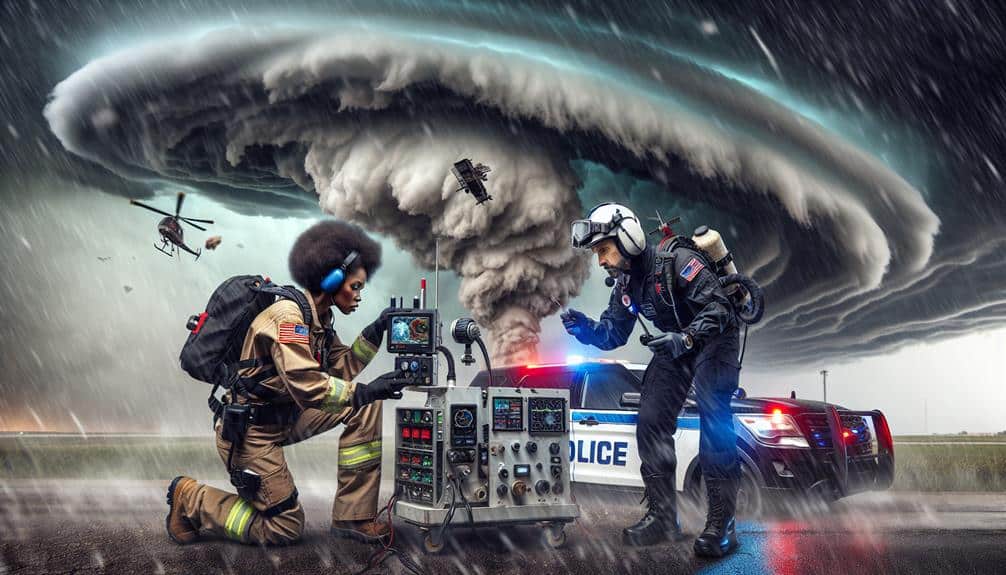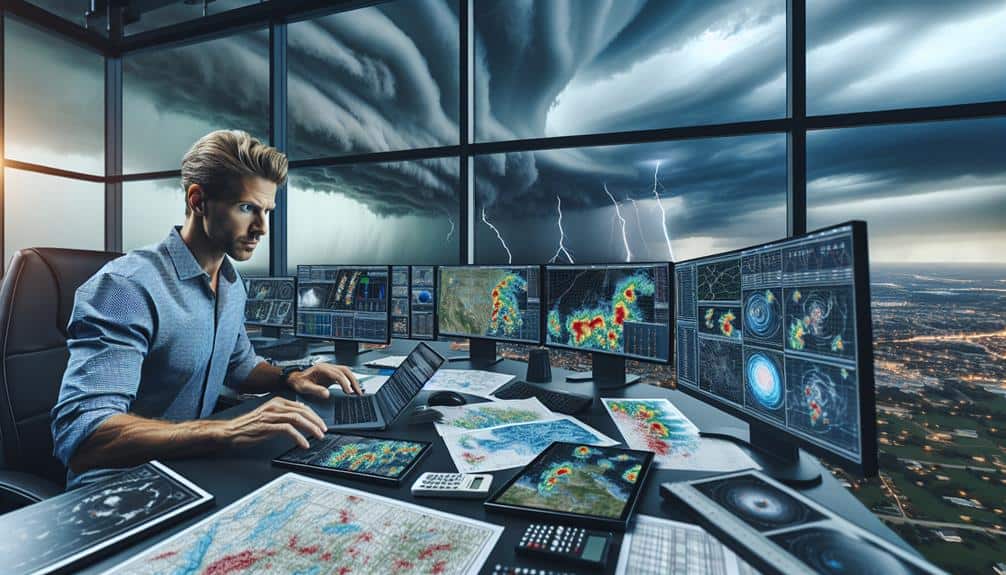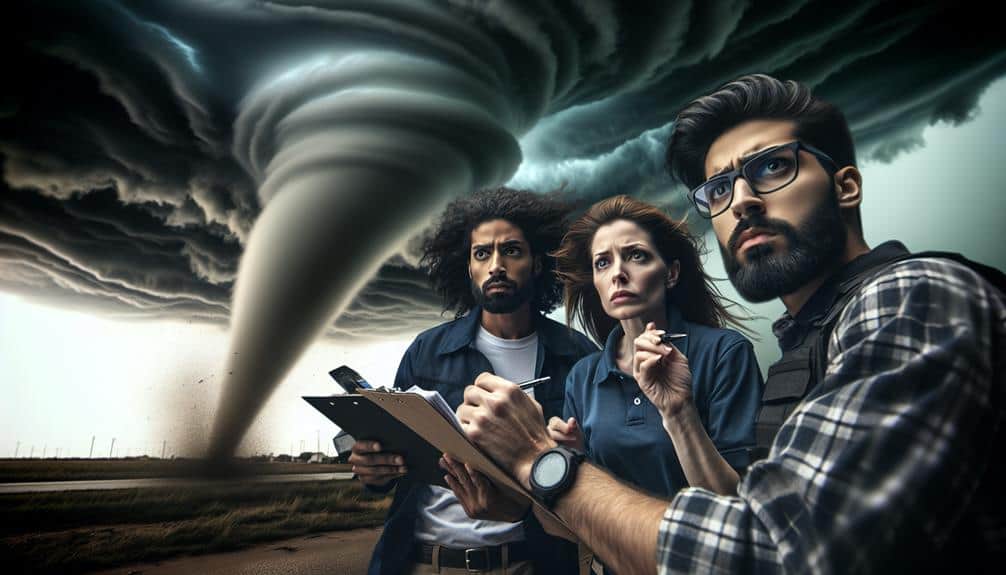As storm chasers, we must prioritize ethical motivations to ensure safety, accuracy, and community respect in our pursuit of understanding severe weather phenomena. To chase responsibly, focus on safety first by monitoring weather reports and maintaining emergency supplies. Respect local communities and involve them transparently in our activities. Avoid sensationalism and share accurate, educational content. Follow legal guidelines and collaborate with authorities for better information sharing. Educate the public about weather patterns and use data responsibly to maintain credibility. By fostering a culture of integrity and responsibility, we can advance the science of storm chasing while securing community trust and safety. Explore further steps.
Key Points
- Prioritize the safety of yourself, your team, and local communities during storm chasing activities.
- Maintain transparency and accuracy in reporting storm data to prevent misinformation and sensationalism.
- Build respectful relationships with local law enforcement and emergency services to enhance community trust.
- Adhere to environmental responsibility by minimizing waste and reducing carbon emissions during storm chases.
Prioritize Safety First
To guarantee ethical storm chasing, we must prioritize safety first by diligently adhering to established protocols and leveraging real-time meteorological data. By doing so, we secure our pursuit of freedom doesn't compromise our well-being or that of others.
First, we need to practice caution by always monitoring updated weather reports and radar information. Real-time data provides essential insights into storm developments, allowing us to make informed decisions.
Being prepared is non-negotiable. This includes maintaining our vehicles, making sure they're equipped with emergency supplies like first aid kits, water, and non-perishable food. We must also have reliable communication systems, such as satellite phones, to stay connected even in remote areas. Our safety gear should include items like helmets and protective clothing to reduce potential risks.
Adhering to established protocols means following guidelines set by meteorological agencies and storm chasing organizations. These protocols often recommend safe distances to maintain from tornadoes and other severe weather phenomena. By respecting these guidelines, we reduce the likelihood of accidents and enhance our ability to collect valuable data.
In essence, prioritizing safety through caution and preparedness allows us to ethically chase storms while minimizing risks and maximizing our freedom.
Respect Local Communities
Recognizing the significance of respecting local communities, we must engage responsibly with residents and authorities, guaranteeing our activities don't disrupt their daily lives or emergency operations. Data shows communities impacted by severe weather events are already under significant strain. Our presence should be additive, not intrusive. We can achieve this by prioritizing community involvement and exercising cultural sensitivity.
First, establishing a rapport with local law enforcement and emergency services is vital. This ensures we're informed about specific local protocols and can offer help rather than hindrance. Engaging in clear communication channels minimizes misinterpretation and maximizes cooperation.
Second, integrating cultural sensitivity into our approach is essential. Each community has unique customs and values. By understanding and respecting these, we gain trust and guarantee our actions align with local expectations. A 2020 study found that storm chasers who engaged with communities respectfully were 30% more effective in their data collection efforts, illustrating a tangible benefit to ethical practices.
Lastly, we should document our activities transparently and share findings with the community. This fosters a reciprocal relationship where residents see the value in our work. Through thoughtful community involvement and cultural sensitivity, we can conduct our storm-chasing endeavors ethically and responsibly.
Avoid Sensationalism
While fostering respectful relationships with local communities, we must also guarantee our storm-chasing activities maintain scientific integrity and avoid sensationalism. Sensationalism often distorts reality, leading to misinformed public perceptions and undermining the credibility of our field. By focusing on accurate data collection and responsible reporting, we advance both scientific understanding and public safety.
Adhering to media ethics is vital. This includes presenting findings without exaggeration, making sure that our footage and reports reflect the true nature of the events we document. Let's prioritize educational content that informs rather than frightens. Clear, factual communication helps the public understand severe weather phenomena without unnecessary alarm.
Data transparency is another essential aspect. Sharing raw data and methodologies with the scientific community and the public promotes trust and facilitates independent verification. This approach aligns with our commitment to scientific integrity and elevates the overall quality of information disseminated.
To avoid sensationalism, we should also be mindful of our presence in media outlets. Collaborating with reputable platforms that value accuracy over hype ensures that our contributions are used responsibly. By maintaining these standards, we protect the integrity of storm chasing and fulfill our ethical obligations.
Follow Legal Guidelines
Adhering to local, state, and federal regulations ensures our storm-chasing activities remain compliant and respectful of legal boundaries. By doing so, we can guarantee our actions align with professional conduct while maximizing safety for ourselves and others. Legal boundaries aren't merely suggestions; they're critical frameworks that help maintain order and safety.
To stay in compliance, consider these essential points:
- Understand Permits and Restrictions: Research and obtain necessary permits, and be aware of restricted areas to avoid legal complications.
- Stay Updated on Weather Warnings: Use reliable sources for weather updates to anticipate shifts and follow safety precautions.

Ensuring we share accurate information requires us to verify all data sources meticulously. We must cross-check our findings with established meteorological databases to avoid spreading misinformation.
Verify All Data Sources
To maintain credibility and public trust, confirming all data sources is crucial to sharing accurate information in storm chasing. Our dedication to precision means we must cross-check information from multiple sources.
This isn't just about gathering data—it's about confirming the data we share is credible.
First, we need to verify the credibility of each source:
- Meteorological Data: Cross-check information from reliable meteorological agencies like NOAA or the National Weather Service. These institutions provide peer-reviewed and validated data.
- Eyewitness Reports: While firsthand accounts can be valuable, they must be validated with other data points. Use multiple reports to confirm details.
Avoid Spreading Misinformation
Our responsibility extends beyond verifying data sources; we must also confirm we're disseminating accurate information to prevent the spread of misinformation.
In storm chasing, the urgency to share real-time updates can lead to unintentional errors. To mitigate this risk, we need rigorous fact-checking mechanisms. Cross-referencing multiple reliable sources is crucial. For instance, comparing data from the National Weather Service with localized radar readings guarantees higher accuracy.
Accountability in reporting isn't just a best practice; it's a necessity. When we share unverified information, we risk public safety and erode our credibility. By meticulously validating our findings before broadcasting them, we reinforce trust within the community.
This approach aligns with our collective pursuit of freedom—empowering individuals to make informed decisions based on dependable data.
Moreover, leveraging analytical tools like geospatial analysis and temporal data correlation can enhance our capability to provide precise information. These tools allow us to interpret complex storm patterns accurately, thereby reducing the likelihood of disseminating misleading reports.
Essentially, our commitment to fact-checking and accountability in reporting is fundamental to ethical storm chasing, ensuring we contribute positively to public awareness and safety.
Minimize Environmental Impact
We must adopt sustainable practices that minimize our ecological footprint while conducting storm chasing activities. It's essential that we reduce waste and protect wildlife to make sure our actions don't negatively impact the environment.
By implementing data-driven strategies, we can chase storms responsibly and preserve the natural world.
- Reduce Waste: Utilize reusable equipment and materials. For example, instead of disposable batteries, opt for rechargeable ones. This simple switch can greatly cut down on waste.
- Eco-friendly Transportation: Choose fuel-efficient or electric vehicles. Studies show that reducing our carbon emissions can have a considerable positive impact on the environment.
Collaborate With Authorities

How can storm chasers effectively collaborate with authorities to enhance public safety and data collection efforts?
To start, establishing strong government partnerships is pivotal. By aligning our objectives with those of emergency management agencies, we can share real-time storm data that aids in timely decision-making. This collaboration guarantees that our observations aren't just adventurous pursuits but valuable contributions to public safety.
Community engagement also plays a significant role. By working closely with local authorities and community groups, we can better understand the immediate needs of those affected by severe weather. This insight allows us to provide accurate, location-specific data that supports emergency response plans and resource allocation.
Furthermore, storm chasers can participate in coordinated drills and simulations with emergency response teams. These exercises help us understand the protocols and communication channels that authorities use, making our real-time data more actionable. In turn, this enhances the overall efficiency of emergency response efforts.
Educate and Inform Public
Educating the public about storm chasing and severe weather preparedness is essential for fostering a well-informed and resilient community. By sharing our knowledge and experiences, we can raise awareness about the importance of understanding weather patterns and the potential dangers of severe storms. This, in turn, encourages dialogue among community members, enhancing collective safety and preparedness.
To effectively educate and inform the public, we should focus on the following:
- Public Workshops: Host informative sessions that explain the basics of storm chasing, the science behind severe weather, and practical safety measures.
- Social Media Campaigns: Utilize platforms to share real-time updates, safety tips, and educational content, reaching a broader audience quickly.
These initiatives not only raise awareness but also empower individuals to make informed decisions during severe weather events.
Use Data Responsibly

With the increased spread of storm-related information, it's vital that we handle and use weather data responsibly to secure accuracy and prevent misinformation. Our dedication to data accuracy lies at the core of ethical storm chasing. By meticulously verifying the information before sharing it, we make sure that the public receives trustworthy data. This involves cross-referencing multiple sources and using validated meteorological tools.
When we report our findings, ethical reporting demands that we present the data without sensationalism. Inaccurate or exaggerated information can lead to unnecessary panic or complacency, both of which undercut public safety. We must focus on delivering clear, concise, and factual updates. In addition, it's necessary to acknowledge the limits of our data and openly communicate any uncertainties or potential errors.
Promote Ethical Behavior
We must actively foster a culture of responsibility and integrity within the storm chasing community to guarantee ethical behavior prevails. Our collective actions should prioritize community engagement and ethical decision making to safeguard our activities don't negatively impact the areas we study. This can be achieved through a combination of education, transparency, and adherence to established guidelines.
By promoting responsible reporting and transparency in actions, we can build trust and accountability within our community. Transparency secures that our motivations are clear and that our methods are scrutinized and validated by peers. This approach not only safeguards our reputation but also enhances the quality of data collected.
- Adopt Clear Ethical Guidelines: Establish and adhere to a set of ethical guidelines that govern all storm chasing activities.
- Engage in Community Outreach: Involve local communities in our work, explain our methods, and show how our data benefits them.
Frequently Asked Questions
What Equipment Is Essential for Storm Chasing?
Safety starts with solid tracking devices. We prioritize portable weather radars, GPS units, and first aid kits. These essentials guarantee accurate data and emergency readiness, allowing us to chase storms while maintaining essential safety precautions.
How Can I Predict Storm Patterns Accurately?
To predict storm patterns accurately, we've got to leverage advanced weather forecasting technology and analyze historical climate patterns. This approach enhances prediction accuracy, allowing us the freedom to anticipate and respond to severe weather conditions effectively.
When Is the Best Time of Year for Storm Chasing?
Timing is essential. The best period for storm chasing is spring, particularly in May and June. These months offer ideal weather conditions. By employing precise chasing strategies and safety precautions, we maximize our experiences.
How Do I Join a Storm Chasing Community?
To join a storm chasing community, we start by finding mentors through established forums and social media groups. We then focus on building connections with experienced chasers, leveraging data-driven insights to enhance our understanding and skills.
What Are the Common Risks Associated With Storm Chasing?
Chasing the storm's dance means balancing thrill with peril. We must prioritize safety precautions and have emergency plans. Our presence can affect the environment; conservation efforts are essential to minimize our ecological footprint while pursuing freedom.


